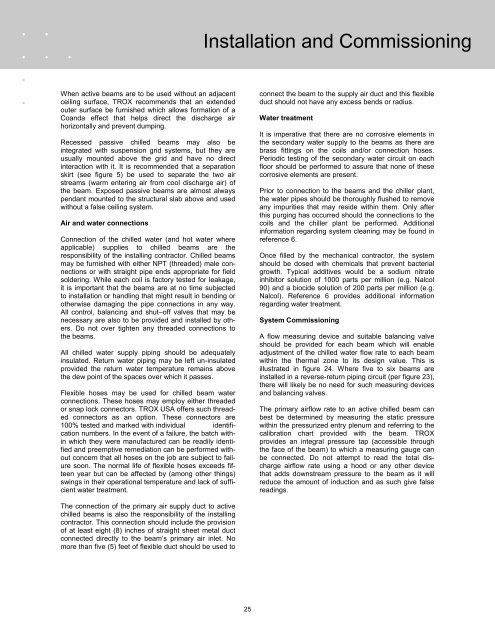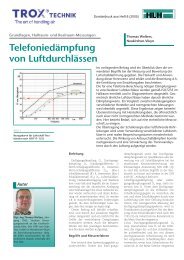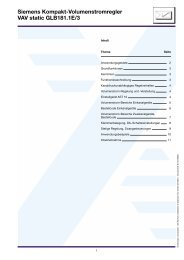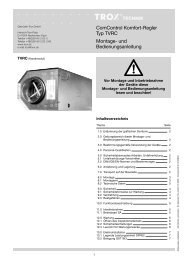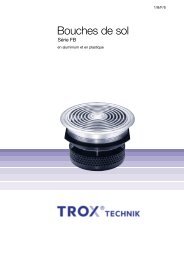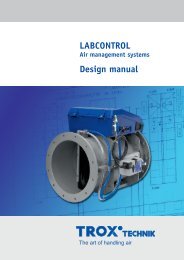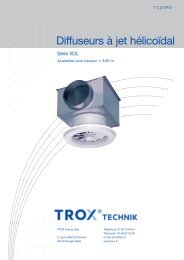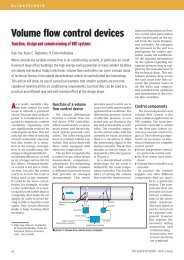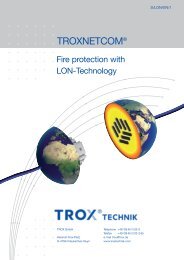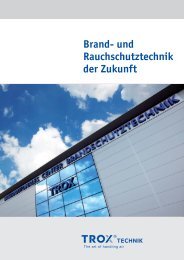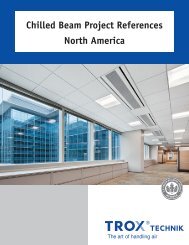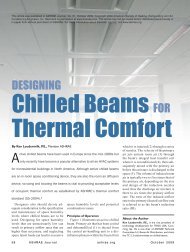Create successful ePaper yourself
Turn your PDF publications into a flip-book with our unique Google optimized e-Paper software.
Installation and Commissioning<br />
When active beams are to be used without an adjacent<br />
ceiling surface, <strong>TROX</strong> recommends that an extended<br />
outer surface be furnished which allows formation of a<br />
Coanda effect that helps direct the discharge air<br />
horizontally and prevent dumping.<br />
Recessed passive chilled beams may also be<br />
integrated with suspension grid systems, but they are<br />
usually mounted above the grid and have no direct<br />
interaction with it. It is recommended that a separation<br />
skirt (see figure 5) be used to separate the two air<br />
streams (warm entering air from cool discharge air) of<br />
the beam. Exposed passive beams are almost always<br />
pendant mounted to the structural slab above and used<br />
without a false ceiling system.<br />
Air and water connections<br />
Connection of the chilled water (and hot water where<br />
applicable) supplies to chilled beams are the<br />
responsibility of the installing contractor. <strong>Chilled</strong> beams<br />
may be furnished with either NPT (threaded) male connections<br />
or with straight pipe ends appropriate for field<br />
soldering. While each coil is factory tested for leakage,<br />
it is important that the beams are at no time subjected<br />
to installation or handling that might result in bending or<br />
otherwise damaging the pipe connections in any way.<br />
All control, balancing and shut–off valves that may be<br />
necessary are also to be provided and installed by others.<br />
Do not over tighten any threaded connections to<br />
the beams.<br />
All chilled water supply piping should be adequately<br />
insulated. Return water piping may be left un-insulated<br />
provided the return water temperature remains above<br />
the dew point of the spaces over which it passes.<br />
Flexible hoses may be used for chilled beam water<br />
connections. These hoses may employ either threaded<br />
or snap lock connectors. <strong>TROX</strong> USA offers such threaded<br />
connectors as an option. These connectors are<br />
100% tested and marked with individual identification<br />
numbers. In the event of a failure, the batch within<br />
which they were manufactured can be readily identified<br />
and preemptive remediation can be performed without<br />
concern that all hoses on the job are subject to failure<br />
soon. The normal life of flexible hoses exceeds fifteen<br />
year but can be affected by (among other things)<br />
swings in their operational temperature and lack of sufficient<br />
water treatment.<br />
connect the beam to the supply air duct and this flexible<br />
duct should not have any excess bends or radius.<br />
Water treatment<br />
It is imperative that there are no corrosive elements in<br />
the secondary water supply to the beams as there are<br />
brass fittings on the coils and/or connection hoses.<br />
Periodic testing of the secondary water circuit on each<br />
floor should be performed to assure that none of these<br />
corrosive elements are present.<br />
Prior to connection to the beams and the chiller plant,<br />
the water pipes should be thoroughly flushed to remove<br />
any impurities that may reside within them. Only after<br />
this purging has occurred should the connections to the<br />
coils and the chiller plant be performed. Additional<br />
information regarding system cleaning may be found in<br />
reference 6.<br />
Once filled by the mechanical contractor, the system<br />
should be dosed with chemicals that prevent bacterial<br />
growth. Typical additives would be a sodium nitrate<br />
inhibitor solution of 1000 parts per million (e.g. Nalcol<br />
90) and a biocide solution of 200 parts per million (e.g.<br />
Nalcol). Reference 6 provides additional information<br />
regarding water treatment.<br />
System Commissioning<br />
A flow measuring device and suitable balancing valve<br />
should be provided for each beam which will enable<br />
adjustment of the chilled water flow rate to each beam<br />
within the thermal zone to its design value. This is<br />
illustrated in figure 24. Where five to six beams are<br />
installed in a reverse-return piping circuit (per figure 23),<br />
there will likely be no need for such measuring devices<br />
and balancing valves.<br />
The primary airflow rate to an active chilled beam can<br />
best be determined by measuring the static pressure<br />
within the pressurized entry plenum and referring to the<br />
calibration chart provided with the beam. <strong>TROX</strong><br />
provides an integral pressure tap (accessible through<br />
the face of the beam) to which a measuring gauge can<br />
be connected. Do not attempt to read the total discharge<br />
airflow rate using a hood or any other device<br />
that adds downstream pressure to the beam as it will<br />
reduce the amount of induction and as such give false<br />
readings.<br />
The connection of the primary air supply duct to active<br />
chilled beams is also the responsibility of the installing<br />
contractor. This connection should include the provision<br />
of at least eight (8) inches of straight sheet metal duct<br />
connected directly to the beam‟s primary air inlet. No<br />
more than five (5) feet of flexible duct should be used to<br />
a<br />
25


